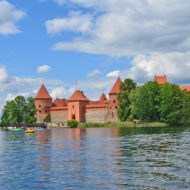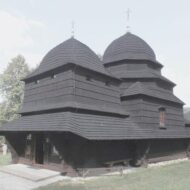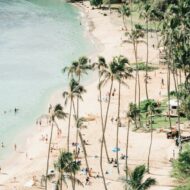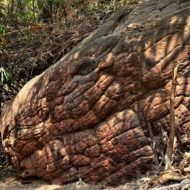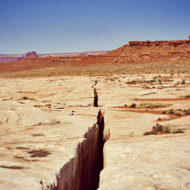Trakai is a historic city and lake resort in Lithuania. It lies 28 kilometres (17 miles) west of Vilnius, the capital of Lithuania. Because of its proximity to Vilnius, Trakai is a popular tourist destination. Trakai is the administrative centre of Trakai district municipality. The town covers 497.1 square kilometres (191.9 square miles) of area and, according to 2007 estimates, is inhabited by 5,357 people. A notable feature of Trakai is that the town was built and preserved by people of different nationalities. Historically, communities of Karaims, Tatars, Lithuanians, Russians, Jews and Poles lived here.
History : The first settlements in this area appeared as early as the first millennium A.D. The town, as well as its surroundings, started developing in the 13th century in the place of Senieji Trakai (Old Trakai). According to a legend after a successful hunting party, Grand Duke Gediminas discovered a beautiful lake-surrounded place not far from Kernave, then capital of the Grand Duchy of Lithuania, and decided to build a castle in the location. That is how the Old Trakai Castle was built in Senieji Trakai. The name of Trakai was first mentioned in Teutonic Knights chronicles in 1337. This year is considered to be the official date of town’s foundation. When Grand Duke Gediminas finally settled in Vilnius, Senieji Trakai was inherited by his son the Duke Kestutis. Duchy of Trakai developed and the town entered its best decades.
Golden age : Grand Duke Kestutis moved the town from Senieji Trakai to its current location, which is sometimes known as Naujieji Trakai. The new location was a place of intensive construction: a new castle was built in the strait between lakes Galve and Luka and known as the Peninsula Castle, and another one, known as the Island Castle, on an island in Lake Galve. A village grew around the castles. Vicinity of Trakai was protected by Senieji Trakai, Streva, Brazuole, Daniliskes and other hillforts from attacks of the Teutonic Knights. Despite the protection, both wooden castles were successfully raided by the Teutonic Knights several times in a row.
he town was in the center of a conflict between Grand Duke Jogaila (later to become King of Poland) with his uncle Kestutis. In 1382 Jogaila’s and Kestutis armies met near Trakai, but Jogaila tricked Kestutis and imprisoned him in Kreva. A few weeks later Kestutis dies in captivity and Jogaila transferred the castles to his brother Skirgaila, who became a governor of Lithuania Proper. However, his rule was briefly interrupted when in 1383 joint forces of Kestutis’s son Vytautas and the Teutonic Knights captured the town. In 1392 Vytautas and Jogaila signed Astrava Treaty ending their quarrel. Vytautas became the Grand Duke of Lithuania while Jogaila technically remained his superior. Vytautas also regained his father’s lands, including Trakai. Despite his official capital being Vilnius, Vytautas spent more time in Trakai. In early 15th century he replaced the older, wooden fortress with a stone-built castle. Some design elements were borrowed from the castles of the Teutonic Knights as Vytautas spent some time with the Teutons forming an alliance against Jogaila in earlier years. Trakai became a political and an administrative centre of the Duchy, sometimes named a de facto capital of Lithuania. Construction of the brick castles was finished and a Catholic church was built. In 1409 the town was granted with Magdeburg Rights; it one of the first towns in Lithuania to get city rights. The village started rapidly developing into a town. In 1413 it became a seat of the Trakai Voivodeship and a notable center of administration and commerce.
Attractions : Trakai Orthodox Church , Chapel of St. John Nepomuk , Angelu Kalva , Kenesa , Church of Nativity of Most Holy Mother of God , Karaim Ethnographic exhibition ,
Trakai History Museum , Trakai Regional Traditional Craft Center , Church of Our Lady of the Assumption , Peninsula Castle ruins , Former Russian Imperial Post Office
The Hill of Angels , Trakai Island Castle , Aukštadvaris Regional Park.
Access : Coordinates: 54.633333, 24.933333 / Trakai is only 18 km from Vilnius and there is good public transport, both by road and by rail / By Bus : Vilnius – Trakai –
Prices range from 4.40 Lt and 6.80 Lt / By train : Vilnius – Trakai Departures: 04:33, 05:24 (Monday – Friday), 06:08, 07:40, 12:34, 13:30, 15:35, 17:55, 20:25. The duration of the route is 35 minutes and the ticket costs 6.20 Lt. By car : Go along Savanorių Avenue, further follow the signs E28 ( A16) motorway.
Activities : ATV AND SNOWMOBILE SAFARI , GO KARTING , Motor Tours , Beach Volley , Bicycle Hire , Guided kayak tours and rental in Trakai , Canoe rent in Aukštadvaris regional park / Pedalboats, boats rent in Trakai , Horseback riding , Hot air Balloon Tours , Paintball , Windsurfing and SUP boarding , Tours by ships on lake Galvė , Trips by Yacht , Water entertainment centre.
Go next :






